24 Hours Hotline: +86 137-3541-1378
Email:info@tripstoshanghai.com
24 Hours Hotline: +86 137-3541-1378
Email:info@tripstoshanghai.com
Nestled on Zhoushan Island in Zhejiang Province, Mount Putuo is one of China’s Four Sacred Buddhist Mountains and a serene escape for travelers seeking spirituality and natural beauty. As you wander through its lush trails and explore its historic temples, you’ll feel a deep sense of peace and calm that has drawn pilgrims and visitors for centuries. From majestic halls dedicated to Guanyin, the Goddess of Mercy, to panoramic views of the East China Sea, Mount Putuo offers a unique combination of cultural heritage, stunning scenery, and a tranquil island atmosphere that makes it a must-visit destination in eastern China.

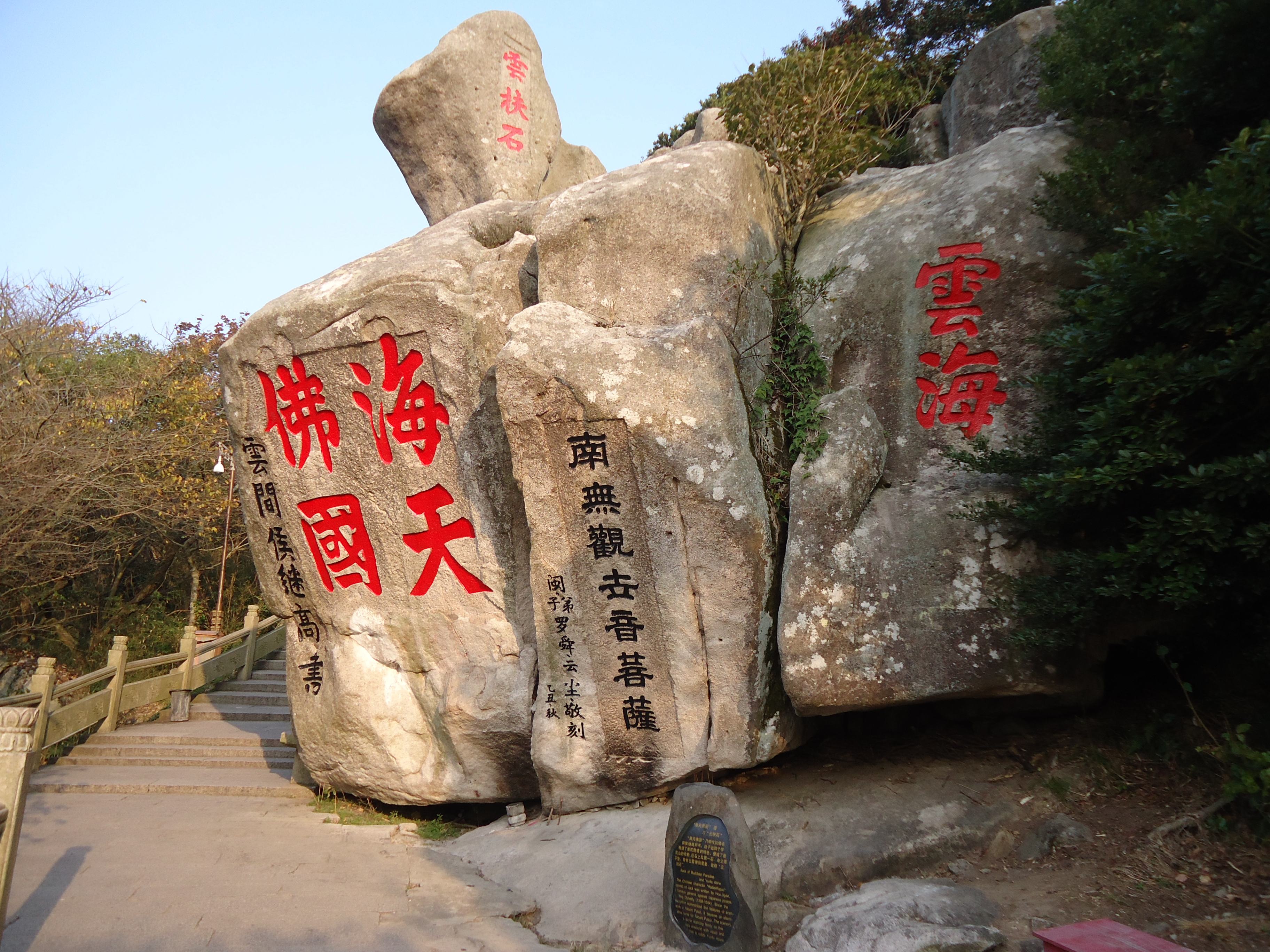
History and Cultural Significance
Mount Putuo has been a center of Buddhist worship for over a thousand years, renowned as the sacred abode of Guanyin, the Goddess of Mercy. Pilgrims from across China and beyond have traveled to this island to pay their respects, seek blessings, and experience its spiritual atmosphere. The mountain’s temples, such as Puji Temple, Fayu Temple, and Cihang Temple, were built during different dynasties and each reflects unique architectural styles and historical artistry. Over centuries, Mount Putuo has also inspired poets, artists, and scholars, who have celebrated its serene landscapes and profound spiritual energy in their works. Today, it continues to blend cultural heritage with natural beauty, offering visitors both a journey through history and a place for peaceful reflection.
Key Attractions on Mount Putuo
Putuoshan's main attractions are three temples: Puji Temple (Front Temple), Fayu Temple (Rear Temple), and Huiji Temple (Buddha Peak Temple), collectively known as the Three Great Zen Temples of Putuoshan. The Three Treasures of Putuoshan, also referred to as the "Three Treasures of the Buddha Kingdom," include the Nine-Dragon Azurite Ceiling, the Guanyin Stele of Yangzhi, and the Multi-Treasure Pagoda (Prince Pagoda). The Three Stones of Putuoshan are Pantuo Stone, Heart-Shaped Stone, and Two Tortoises Listening to Dharma Stone. The Three Caves of Putuoshan are Chaoyang Cave, Chaoyin Cave, and Fanyin Cave. The Twelve Scenic Spots of Putuoshan are Lianyang Afternoon Crossing, Shuanggu Sacred Relics, Meiwan Spring Dawn, Pantuo Evening Glow, Lianchi Night Moon, Fahua Spiritual Cave, Ancient Cave Chaoyin, Chaoyang Rising Sun, Thousand Steps Golden Sand, Guangxi Snow Break, Chashan Early Mist, and Tianmen Clear Dharma.
Puji Temple
Puji Temple, also known as the Front Temple, was established during the Song Yuanfeng period (1078–1085). It is the largest temple on Putuoshan and a national key temple. The abbots of Putuoshan throughout history have resided here. The temple is vast and is known for its “five steps, one tower; ten steps, one pavilion” design. The temple consists of six courtyards aligned along a central axis from south to north. The main hall, the Great Yuan Tong Hall, enshrines a statue of Avalokitesvara (Guanyin) that is 8.8 meters tall. On either side are statues of Avalokitesvara in "Thirty-Two Transformations," symbolizing the Bodhisattva’s compassion for all beings in the world.

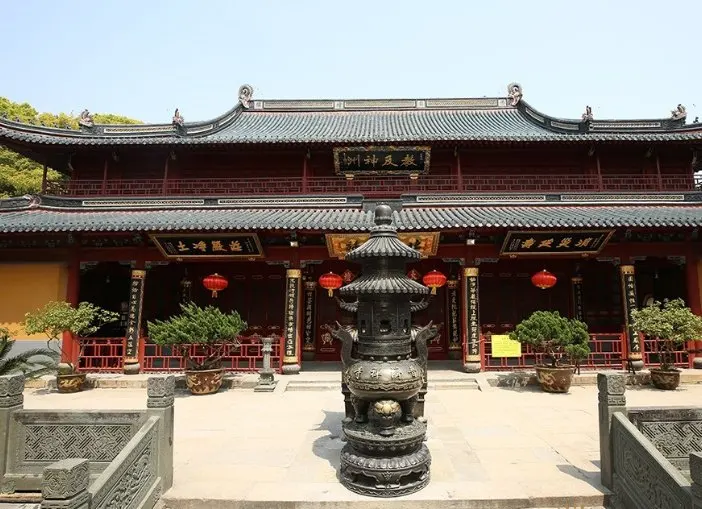
Fayu Temple
Fayu Temple, also known as the Rear Temple, was originally named Haichao An. In the 38th year of the Kangxi reign (1699), it was granted the name "Tianhua Fayushi" and became known as Fayu Temple. The temple’s architectural layout follows the natural terrain, with buildings ascending in groups. The most magnificent building is the Jiulong Hall, which was relocated from the Ming Imperial Palace in Nanjing. Inside the hall is one of the Three Treasures of Putuoshan, the "Nine-Dragon Azurite Ceiling."
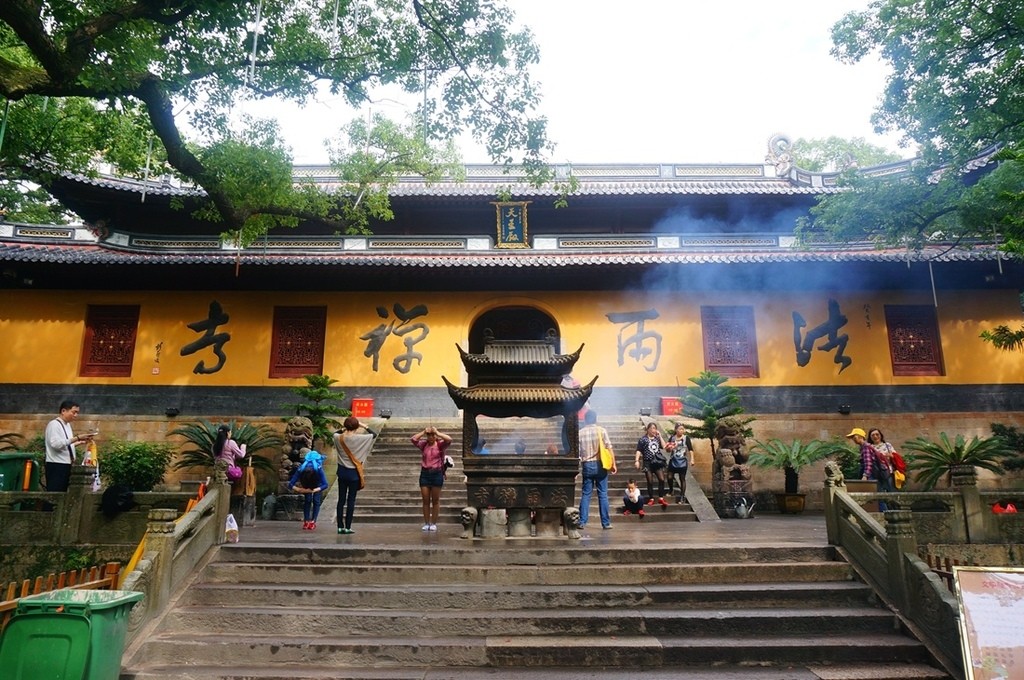

Huiji Temple
Huiji Temple is located at the highest point of Putuoshan, Buddha Peak (Foding Mountain), and is also known as Buddha Peak Temple. The layout of the temple is unique compared to other Zen temples, with the Tianwang Hall, Mahavira Hall, Great Compassion Hall, Sutra Hall, Jade Emperor Hall, and Abbot's Room all aligned on a single horizontal axis, reflecting the style of Zhejiang Eastern Garden architecture. Unlike other temples on Putuoshan, the main hall of Huiji Temple is the Mahavira Hall, which houses a statue of Sakyamuni Buddha. The Great Compassion Hall on the right enshrines a Tang Dynasty statue of Guanyin, the oldest Buddha statue on Putuoshan. The temple’s roof is covered with glazed tiles in shades of sky blue, pale green, goose yellow, and purple-red, which create a rainbow effect in the sunlight, symbolizing the "Buddha’s light illuminating the world."


Standing Guanyin Statue
The Standing Guanyin Statue is located at the top of Longwan Hill in the southeastern part of Putuoshan Scenic Area. The statue stands 33 meters tall, with a 13-meter-high base, an 18-meter-high bronze statue, and a 2-meter lotus pedestal, weighing over 70 tons. The statue’s base is a 1,000-square-meter Merit Hall, with 500 smaller statues of Guanyin in various forms. The upper hall is decorated with large wooden carvings of Guanyin's legendary stories and colorful jade carvings depicting the scenic views of Putuoshan.


South Gate (Nantianmen)
Nantianmen is located on Nanshan, the southern part of Putuoshan, directly opposite the Shuanggu Dao Head. The gate is perched on a cliff, isolated from the island, connected by a stone bridge that resembles a dragon, known as the Huolong Bridge. The area is surrounded by towering rocks, with two stones resembling a gate, hence the name "South Gate." The gate’s flying eaves are decorated with the inscription “Nantianmen,” and there is a dragon-eye well and a stone drum on the cliffs. To the left of the gate is a stone lion. Inside the gate, there is a collection of magnificent rocks, with the sea’s vast waves in front. The site is rich in cliff carvings, including the inscription "Dragon Hua Grand Meeting," "The Pillars of the South Sky," and "The Lonely Coast." Legend has it that this is the place where the Eight Immortals crossed the sea, and the founder of the Putuoshan Zen tradition, Zhen Xie, once meditated here.


Guanyin Cave
Guanyin Cave, also known as the Ancient Guanyin Cave, is the largest stone cave on Putuoshan. Upon entering the mountain gate, there is a yellow temple wall with the inscription "Namo Guanshiyin Bodhisattva," which locals refer to as the "Bodhisattva Wall." The cave is a large stone chamber formed naturally, with a flat and even floor. A stone pillar hangs down from the ceiling, broad at the top and tapering at the bottom, creating the phenomenon known as "Clouds Hanging, Waves Falling." The cave is filled with a spiritual atmosphere, with carvings of Avalokitesvara's compassionate form on the walls and pillars. The ceiling bears the inscription "The Bodhisattva’s Reappearance" in characters 1.5 meters in diameter. The cave is next to a small monastery, which was originally a thatched hut during the Ming Dynasty (1572–1620) and later developed into a monastery during the Qing Dynasty. In 1983, a statue of Avalokitesvara was carved by the Zhejiang Academy of Fine Arts and placed in the main hall.
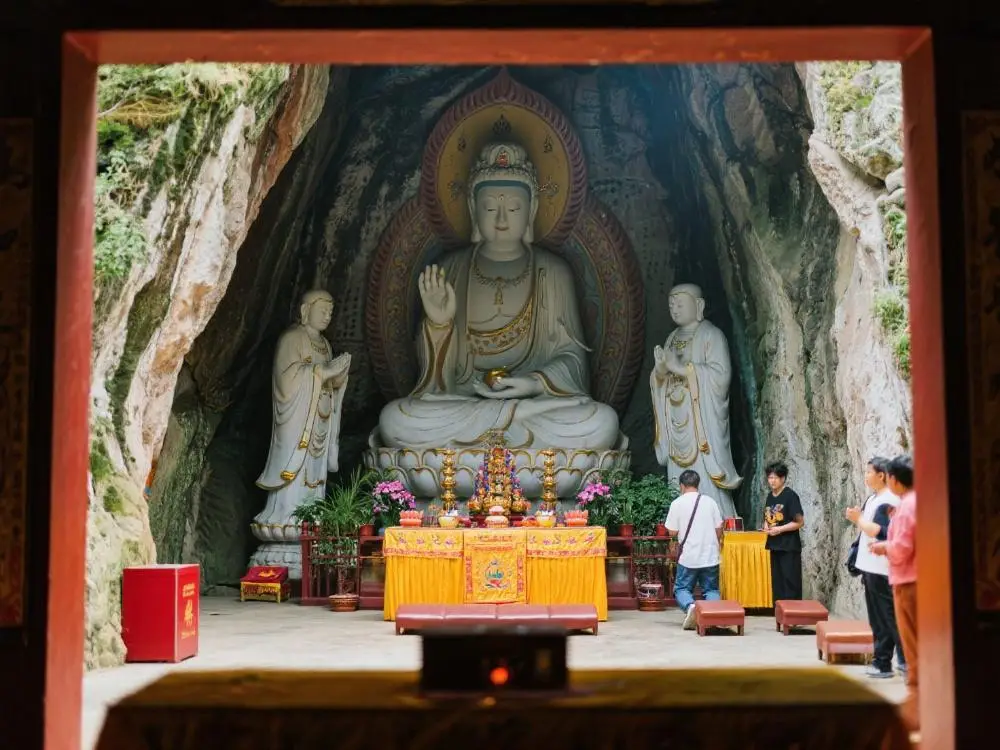

Zizhu Lin (Purple Bamboo Forest)
Zizhu Lin is located at the southeastern foot of Meitan Mountain on the southern side of Putuoshan. The Zizhu Lin Monastery is situated to the south of Baibu Sha and west of Chaoyin Cave, facing the sparkling Lianhua Bay, with Mount Luojia across the sea. The monastery is built with the mountain behind and the sea in front. Its sign, "Bupian Zizhu Lin" (?????), was inscribed by the famous modern thinker Kang Youwei. The main hall enshrines a white marble statue of the Purple Bamboo Guanyin, with different forms that inspire various spiritual blessings. In front of the monastery is a vast valley.
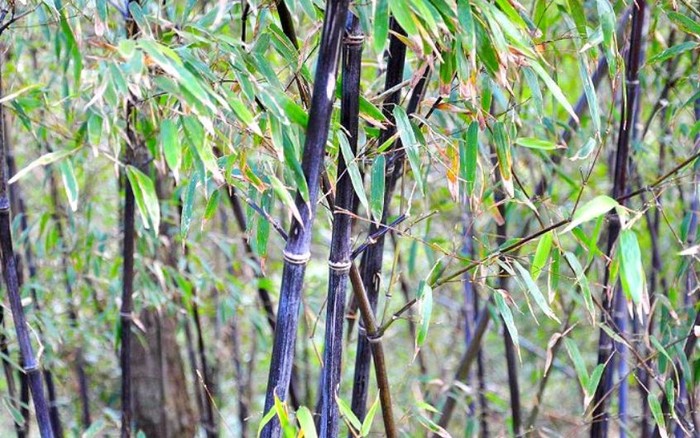
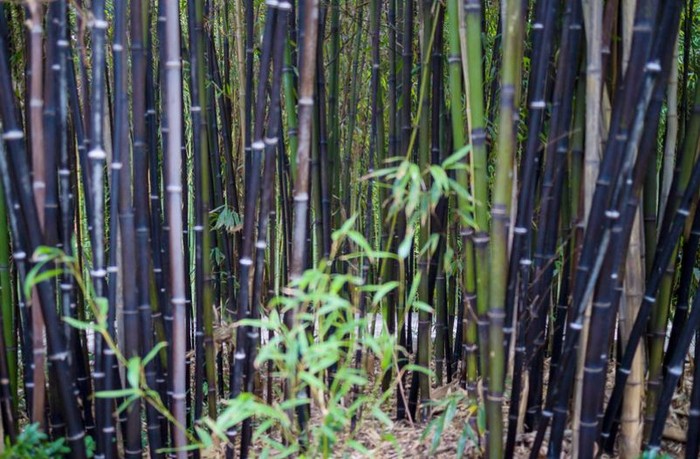
Buken Qu Guanyinyuan (The "Not Willing to Leave" Guanyin Monastery)
Located near Zizhu Lin, Buken Qu Guanyinyuan is where Master Huie, the monk who refused to leave, once worshipped Guanyin. It is the origin of the Guanyin Buddhist teachings on Putuoshan. The main hall houses a Tang-style statue of Eleven-Faced Guanyin. On the western side of the monastery, there is a corridor named "Thirty-Three Guanyin Spiritual Altar," with statues of the thirty-three main Guanyin figures from Japanese temples.


Activities for Visitors
At Mount Putuo, you can immerse yourself in a variety of activities that combine spirituality, nature, and culture. Explore historic temples like Puji, Fayu, and Cihang, and admire the intricate Buddhist architecture and sacred Guanyin statues. Take peaceful walks along trails such as Zizhulin (Purple Bamboo Forest) and Nantianmen (South Heaven Gate) to enjoy panoramic views and serene surroundings. Capture stunning photos of the coastal scenery, forested paths, and temple courtyards. If you’re looking for reflection or meditation, you’ll find quiet corners throughout the mountain that offer the perfect setting to connect with nature and the spiritual essence of Mount Putuo.
Practical Tips for Travelers
Wear Comfortable Shoes: Mount Putuo has many trails, stairs, and uneven paths, so sturdy walking shoes are recommended.
Bring Essentials: Carry water, sun protection, and light snacks, especially if you plan to hike or explore for several hours.
Arrive Early: Popular temples and the Guanyin Statue can get crowded, so arriving early helps you enjoy a more peaceful experience.
Respect Local Customs: Keep quiet in temple areas and dress modestly to honor the spiritual atmosphere.
Photography: Don’t forget your camera to capture the breathtaking coastal views, bamboo forests, and historic temple architecture.
What to Buy
Near Puji Temple there is a night market that sells a variety of souvenirs, statues and raw seafood, a number of convenience stores, and a few restaurants offering inexpensive meals.
What to Eat
1. Temple food. Inexpensive vegetarian fare is available at many of the temples. Note: Eating times are from 11.30-12.00 for lunch and 16.00-17.00 for dinner.
2. Vegetarian. As a Buddhist island, most of the island's restaurants offer a good selection of vegetarian dishes.
3. Chinese dishes. The hotels near Puji Temple have restaurants that are open to non-residents.
4. Seafood. The new village, south of the ferry terminal, boasts many seafood restaurants with an excellent fresh selection. Prices are 20-25% dearer than the mainland, but the quality of shellfish and fish is first rate. The non-Chinese speaker will have to point to the display and hope for the best.
Note: There are mostly no English Menues available and the staff does not speak any English, also in the bigger Hotel-Restaurants. If so, you are lucky! Don`t forget your English-Chinese dictionary, especially for food with Chinese Characters. And there is no restaurant on the island serving Western food. If you are lucky you get some toast for breakfast in the hotels.
Information
Transportation:
Many of the Zhoushan Islands are now linked by bridges. This means that Putuoshan can easily be reached by bus from Shanghai and Hangzhou. The bus terminates at Shenjiamen Bus Station. From the Banshengdong Wharf on the Shenjiamen waterfront it is a 10 minute ride by fast ferry (22rmb) to Putuoshan.
From Shanghai to Putuo Mountain:
1)By Boat: The best way to get there is take the overnight ferry departing from the Shanghai Wusong Port every evening (at 19:20/20:00 – arriving the next day at 07:00/07:30). Tickets are available at the ferryboat agency (No. 59 East Jinling Road; Tel: 021-63283120; business hours 07:00 – 17:30) two days prior to departure. Passengers should note that boarding is at the Wusong Passenger Transportation Center (Tel: 021 – 56575500), not Wusong Port itself.
2) By Bus: In Shanghai, the Nanpu Bridge Bus Station, Shanghai Stadium Sightseeing Bus Center and Shanghai South Long Distance Bus Station have several departures daily to Shenjiamen (4-5 hours, 138rmb).
From Hangzhou to Putuo Mountain:
1, Depart at Hangzhou East Bus Station to Shenjiamen Bus Station every day(From06:55-17:45, evevry 1 hour per bus). Ticket price:77RMB Per Ticket. Arrive in shenjiamen Bus Station, take Public Bus No.7 or No.7 and get off at Banshendong Wharf. (Take taxi is about 8RMB/car)
2, Depart at Huanglong Sport Center to the Banshendong Wharf. Four buses everyday, namely:
7:30/ 9:30/ 14:00/ 16:00
3, Depart at Wushan Square to the Banshendong Wharf. Four buses everyday, namely:
8:00 / 9:00 / 14:30 / 16:30
Address: No. 115 Meiling Road, Putuo District, Zhoushan City, Zhejiang Province.
Opening hours: 8:00 a.m. - 5:00 p.m.
Admission fee:
CNY 140 (Dec.1-Jan.31)
CNY 160 (Feb.1-Nov.30)
CNY 200 during the legal holidays;
Excluding:
CNY 5 for the Puji Temple
CNY 5 for the Fayu Temple
CNY 5 for the Huiji Temple
CNY 5 for the Violet Bamboo Grove Buddhist Temple (Zizhu Lin)
CNY 6 for the Standing Kwan-yin Statue of Mt. Putuoshan
CNY 49 for the Luojia Hill
CNY 40 for the round-trip cable car or CNY 25 for the one-way cable car
Tour The Putuo Shan (Putuo Mountain) with Your Way Holiday
We design private and tailor-made Hangzhou Tours customized to your style of travel at affordable local prices. We will provide a private & spacious car and a local professional tour guide with over 5 years guiding experience only work for you or your group. Transport, ticket, and dining (We find the most authentic dishes popular with locals) all we will arrange for you according your requirements. Please check our most popular Hangzhou Tours including The Putuo Shan (Putuo Mountain) as below:
Are the above sample tour programs not suitable for you? We have more Hangzhou Tours. Our tours can be tailor-made based on your requirements and budget to create unique Hangzhou experiences that allow you to interact with the local people and culture. We are Hangzhou travel experts who know what your guidebook and foreign agencies don't. Our enthusiastic tour expert will promptly reply you in details within 24 hours.
Prev: China National Tea Museum Hangzhou
Next: Zhexi Grand Canyon
Duration:6-8 Hours
Attractions(Cities):West Lake Boat Cruise, Viewing Fish at the Flower Pond, Guo Garden, Meijiawu Tea Plantation, Bamboo-lined Path at Yunqi, Hefang Street
Tour Style:Embark on an enchanting Hangzhou journey with our seasoned expert and a skilled driver. Glide gracefully across West Lake's tranquil waters, escaping crowds for an intimate boat ride. Immerse in Chinese traditions with a mesmerizing tea ceremony at Longjing Green Tea Plantation. Wander the Bamboo-lined path at Yunqi, savoring Hangzhou's serene beauty. Our expert guide shares captivating tales of history, complemented by a skillful driver navigating effortlessly. Indulge in a day of discovery, each corner revealing Hangzhou's captivating allure, leaving you with cherished memories.
Duration:6-8 Hours
Attractions(Cities):West Lake Boat Cruise, Viewing Fish at the Flower Pond, China National Tea Museum, Meijiawu Tea Plantation, Longjing Imperial Tea Garden
Tour Style:Hangzhou, known as the land of fish and rice and the home of tea and silk, offers a unique tea experience. Join your experienced guide on an 8-hour tour dedicated to exploring China’s rich tea culture. Begin at the China National Tea Museum, where you'll delve into the history of tea and view a fascinating collection of artifacts. Then, visit the Meijiawu Tea Plantation, famous for producing Longjing tea. Here, you'll taste the celebrated tea and engage with local tea farmers. The tour also includes a stop at the Longjing Imperial Tea Garden, home to the Eighteen Imperial Tea Bushes, celebrated since the Qing Dynasty. This immersive experience offers a deep appreciation of Chinese tea culture, surrounded by Hangzhou's stunning landscapes. Whether you're a tea enthusiast or simply curious, this tour provides a memorable insight into one of China’s most treasured traditions.
Duration:5 Days, 4 Nights
Attractions(Cities):Hangzhou, Suzhou
Tour Style:Embark on a Suzhou and Hangzhou tour that offers a perfect blend of cultural discovery and scenic beauty. Explore the rich heritage of these two iconic cities, each known for its timeless landscapes, ancient traditions, and tranquil ambiance. From serene boat cruises and tea plantations in Hangzhou to the classical gardens and historic streets of Suzhou, this journey allows you to deeply connect with the heart of China’s culture. Immerse yourself in local customs, enjoy personalized service, and create lasting memories as you experience the best of these enchanting destinations. Whether you're seeking peaceful retreats, cultural exploration, or adventure, this tour offers a truly enriching experience.
Duration:6-8 Hours
Attractions(Cities):West Lake Boat Cruise, Viewing Fish at the Flower Pond, Lingyin Temple, Anmanfayun Village, Meijiawu Tea Plantation, Southern Song Imperial Street
Tour Style:Embark on a hassle-free and time-efficient exploration of Hangzhou with our comprehensive Skip-The-Line full-day tour. Cruise around the UNESCO-listed West Lake on a boat, marvel at the scenic beauty of Fish Viewing at Flower Park, explore the tranquil Zen monastery of Lingyin Temple, indulge in a tea-sipping experience at Meijiawu Tea Village, and wander through the historical Song Dynasty Imperial Street. Our guided tour ensures you skip the queues, allowing you to seamlessly access each scenic spot. Make the most of your time with a well-organized itinerary, ensuring a smooth and enjoyable journey through the captivating sights of Hangzhou.
Duration:10+ Hours
Attractions(Cities):West Lake Boat Cruise, Guo Garden, Meijiawu Tea Plantation, Bamboo-lined Path at Yunqi, Hefang Street, Impression West Lake Show
Tour Style:Discover the renowned Paradise City, Hangzhou, on a fully customized day trip from Shanghai by bullet train. Accompanied by your private guide, stroll through Flower Harbor Park, take a relaxing boat ride on West Lake, and visit the historic Lingyin Temple. Explore the traditional Meijiawu Tea Mountain, wander along the charming Hefang Street, and enjoy the spectacular Impression West Lake show. The tour includes local lunch and dinner, tea tasting at Meijiawu, round-trip bullet train tickets, private guide, and private vehicle service, ensuring a seamless and enriching experience.
Wechat: Chinaprivatetour
24 Hours Hotline:
+86 137-3541-1378
(Your Privacy is Protected)
1 to 1 tailor-made service from our professional travel advisors for the most sophisticated
Constantly excellent reviews for attraction, hotel and service Competitive price
Local experts provide quality tours Best selected knowledgeable local guides Authentic local restaurants
7*24 hours available to create you a worry-free tour. No Hidden Fees and absolutely no pressure to buy. Secured








Copyright © 2017 Hangzhouprivatetour.com All rights reserved.